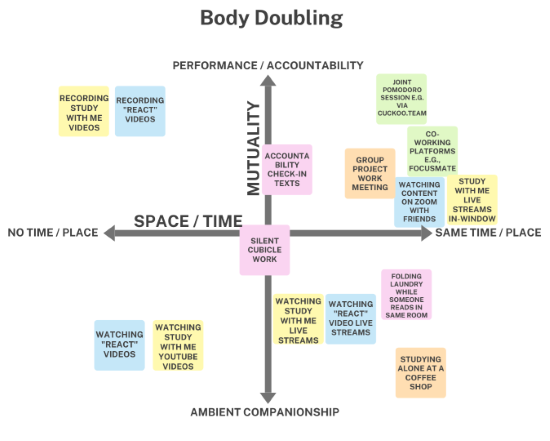A Survey of Body Doubling
Background
Project Year: 2022 - 2024
Extended Abstract
Full Paper
Objectives
- Explore how neurodivergent individuals define and use body doubling.
- Establish body doubling as an adaptive strategy for task completion/initiation for ND individuals
- Publish a community-driven definition of a colloquial phenomenon
Methods
- Survey of 220 neurodivergent participants
- Recruited from neurodivergent subreddits and personal Twitter and TikTok accounts
- Explored themes around knowledge of, experiences with, and use of body doubling
- Average age = 34.2, range from 18 - 72
What is body doubling?
- Having someone in the room (n = 127) or on a call/chat (n = 27)
- To accomplish a task (n = 65) / be productive (n = 38)
- Tasks may be different (n = 65) or similar (n = 13)
- Form of accountability (n = 23) and helps one stay on task (n = 21)
Mapping Body Doubling
We propose that body doubling is a spectrum of (primarily) two things – Space/Time and Mutuality (see below figure). This model reflects the flexibility we saw participants utilizing. First, a spectrum of space and temporality exists. This addresses the “liveness” of the body double. The space-time spectrum ranges from happening in real-time, in a shared space to pre-recorded in a different space. Second, there are differing levels of mutuality and awareness on the part of the entity acting as the body double. This spectrum ranges from someone who knows what you are doing and you can be accountable to, to someone sharing a space but unaware of their role as a body double.

